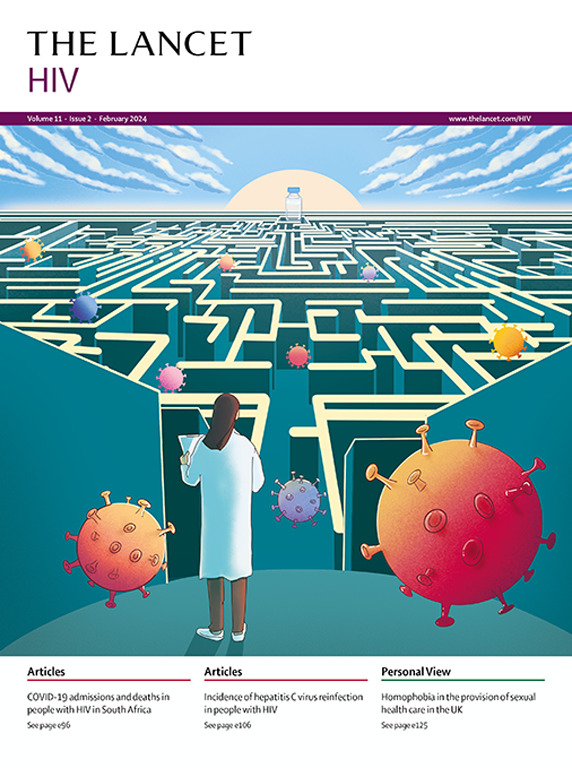The impact of cuts in the US President's Emergency Plan for AIDS Relief funding for HIV pre-exposure prophylaxis in sub-Saharan Africa: a modelling study.
IF 13
1区 医学
Q1 IMMUNOLOGY
引用次数: 0
Abstract
BACKGROUND In January, 2025, the US Government issued a directive, pausing all foreign aid programmes. This directive included a 90-day pausing of all US President's Emergency Plan for AIDS Relief (PEPFAR) funding for HIV oral pre-exposure prophylaxis (PrEP) except for pregnant and breastfeeding women, with a return to funding for PrEP looking increasingly unlikely. We aimed to estimate the impact of a funding pause for PrEP on HIV infections in sub-Saharan Africa. METHODS In this mathematical modelling study, we developed a static HIV transmission model incorporating PrEP, parameterised with estimates of population size, HIV prevalence and incidence, and PrEP effectiveness for different subpopulations (including key populations) in each PEPFAR-funded sub-Saharan African country. Key populations were men who have sex with men, female sex workers, transgender women, and people who inject drugs. We used PEPFAR reporting on numbers of people in different subpopulations returning for oral PrEP for each country in July to September, 2024, as the estimated number using oral PrEP provided by PEPFAR. For each country and subpopulation, we modelled the relative and absolute increase in new primary HIV infections resulting from removing this funded PrEP for a year and the number of secondary infections that could result from these primary infections during the next 5 years. FINDINGS Towards the end of 2024, 719 384 individuals who were not breastfeeding or pregnant, including 205 868 people from key populations, received PEPFAR-funded PrEP across 28 sub-Saharan African countries. The estimated proportion of HIV-negative key population individuals receiving PEPFAR-funded PrEP (ie, the coverage) ranged from 2·6% (95% uncertainty interval 2·0-3·4) in people who inject drugs to 5·0% (4·5-5·9) in female sex workers. Estimated coverage among non-key population men was less than 0·1% (<0·1 to <0·1) and in women was 0·1% (0·1 to 0·1). Stopping PEPFAR's provision of PrEP for a year could lead to 6671 (5032-8192) additional new primary HIV infections, including 5663 (4146-7074) in key populations. Within key populations, this absolute increase corresponds to relative increases in new HIV infections of 0·8% (0·3-1·5) in people who inject drugs, 1·4% (0·8-2·3) in transgender women, 2·2% (1·3-3·0) in men who have sex with men, and 2·9% (1·8-4·4) in female sex workers. In Zambia, the country with the highest PEPFAR coverage across all key populations, this increase ranges from 7·8% (2·5-17·1) in people who inject drugs to 18·1% (9·7-33·2) in men who have sex with men. When considering secondary transmissions, we estimated that a 1-year pause could lead to 10 313 (7796-12 921) additional infections during the next 5 years. INTERPRETATION Our projections show the substantial detrimental impacts that cuts to PEPFAR funding could have. Mitigation measures, including funding through alternative international donors or domestic government budgets, are needed to maintain and increase existing coverage levels of PrEP and therefore prevent the detrimental impact of PEPFAR's funding cuts, particularly in high coverage countries. FUNDING Wellcome Trust. TRANSLATION For the French translation of the abstract see Supplementary Materials section.削减美国总统艾滋病紧急救援计划对撒哈拉以南非洲艾滋病毒暴露前预防的供资的影响:一项模拟研究。
2025年1月,美国政府发布指令,暂停所有对外援助项目。该指令包括暂停美国总统艾滋病紧急救援计划(PEPFAR)对艾滋病毒口服暴露前预防(PrEP)的所有资助(孕妇和哺乳期妇女除外)90天,恢复对PrEP的资助看起来越来越不可能。我们的目的是估计暂停为撒哈拉以南非洲的艾滋病毒感染提供预防措施的影响。在这项数学建模研究中,我们建立了一个包含PrEP的静态HIV传播模型,参数化了每个pepfar资助的撒哈拉以南非洲国家的人口规模、HIV患病率和发病率以及PrEP对不同亚人群(包括关键人群)的有效性的估计。重点人群是男男性行为者、女性性工作者、变性女性和注射吸毒者。我们使用PEPFAR报告了2024年7月至9月每个国家不同亚群返回口服PrEP的人数,作为PEPFAR提供的口服PrEP的估计人数。对于每个国家和亚人群,我们模拟了由于取消这项资助的PrEP一年而导致的新发原发性艾滋病毒感染的相对和绝对增长,以及这些原发性感染在未来5年内可能导致的继发感染数量。截至2024年底,撒哈拉以南非洲28个国家的719,384名未母乳喂养或未怀孕的人,包括来自重点人群的205,868人,接受了pepfar资助的PrEP。接受总统防治艾滋病紧急救援计划资助的预防措施的艾滋病毒阴性关键人群的估计比例(即覆盖率)从注射吸毒者的2.6%(95%不确定区间为2.0 - 3.4)到女性性工作者的5.0%(4.5 - 5.9)不等。非重点人群中男性的估计覆盖率小于0.1%(< 0.1至< 0.1),女性的估计覆盖率为0.1%(0.1至0.1)。停止PEPFAR提供PrEP一年可能导致6671(5032-8192)例新的原发性艾滋病毒感染,其中包括关键人群中的5663(4146-7074)例。在重点人群中,这一绝对增长对应于注射吸毒者中艾滋病毒新发感染的相对增长:0.8%(0.3 - 1.5)、变性女性中1.4%(0.8 - 2.3)、男男性行为者中2.2%(0.3 - 0.3)、女性性工作者中2.9%(1.8 - 4.4)。赞比亚是总统防治艾滋病紧急救援计划在所有关键人群中覆盖率最高的国家,注射吸毒者的这一增幅为7.8%(2.5 - 17.1),男男性行为者的这一增幅为18.1%(9.7 - 33.2)。当考虑到二次传播时,我们估计1年的暂停可能导致在未来5年内增加10 313例(7796-12 921)例感染。我们的预测显示了削减PEPFAR资金可能产生的重大不利影响。需要采取缓解措施,包括通过替代性国际捐助方或国内政府预算提供资金,以维持和提高预防PrEP的现有覆盖水平,从而防止总统防治艾滋病紧急救援计划削减资金的不利影响,特别是在高覆盖国家。FUNDINGWellcome信任。摘要的法文译本见补充资料部分。
本文章由计算机程序翻译,如有差异,请以英文原文为准。
求助全文
约1分钟内获得全文
求助全文
来源期刊

Lancet Hiv
IMMUNOLOGYINFECTIOUS DISEASES&-INFECTIOUS DISEASES
CiteScore
19.90
自引率
4.30%
发文量
368
期刊介绍:
The Lancet HIV is an internationally trusted source of clinical, public health, and global health knowledge with an Impact Factor of 16.1. It is dedicated to publishing original research, evidence-based reviews, and insightful features that advocate for change in or illuminates HIV clinical practice. The journal aims to provide a holistic view of the pandemic, covering clinical, epidemiological, and operational disciplines. It publishes content on innovative treatments and the biological research behind them, novel methods of service delivery, and new approaches to confronting HIV/AIDS worldwide. The Lancet HIV publishes various types of content including articles, reviews, comments, correspondences, and viewpoints. It also publishes series that aim to shape and drive positive change in clinical practice and health policy in areas of need in HIV. The journal is indexed by several abstracting and indexing services, including Crossref, Embase, Essential Science Indicators, MEDLINE, PubMed, SCIE and Scopus.
 求助内容:
求助内容: 应助结果提醒方式:
应助结果提醒方式:


